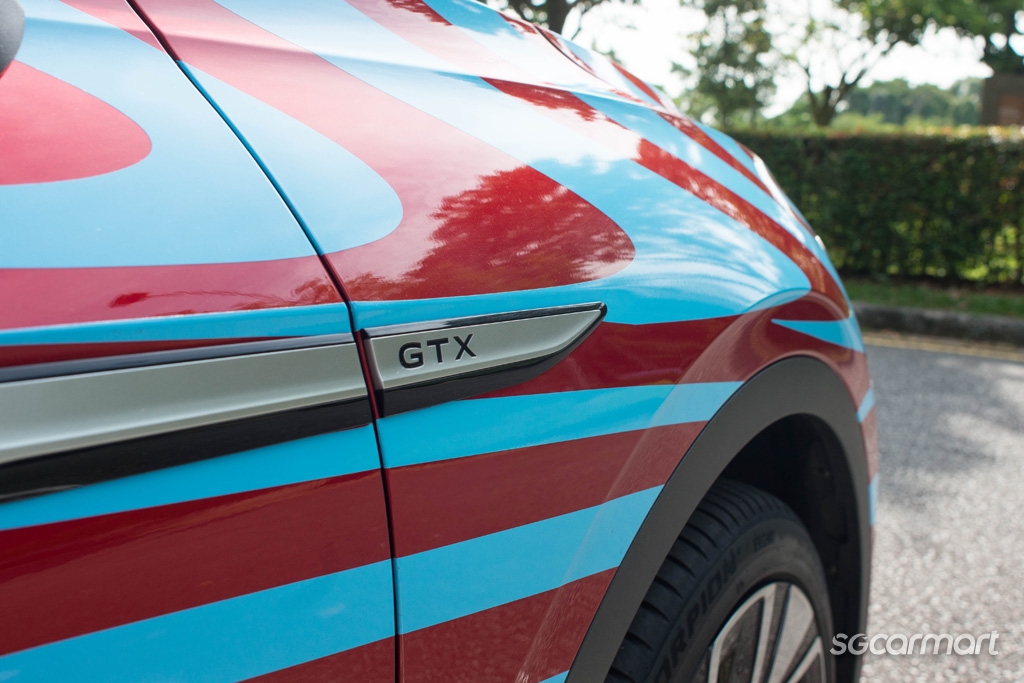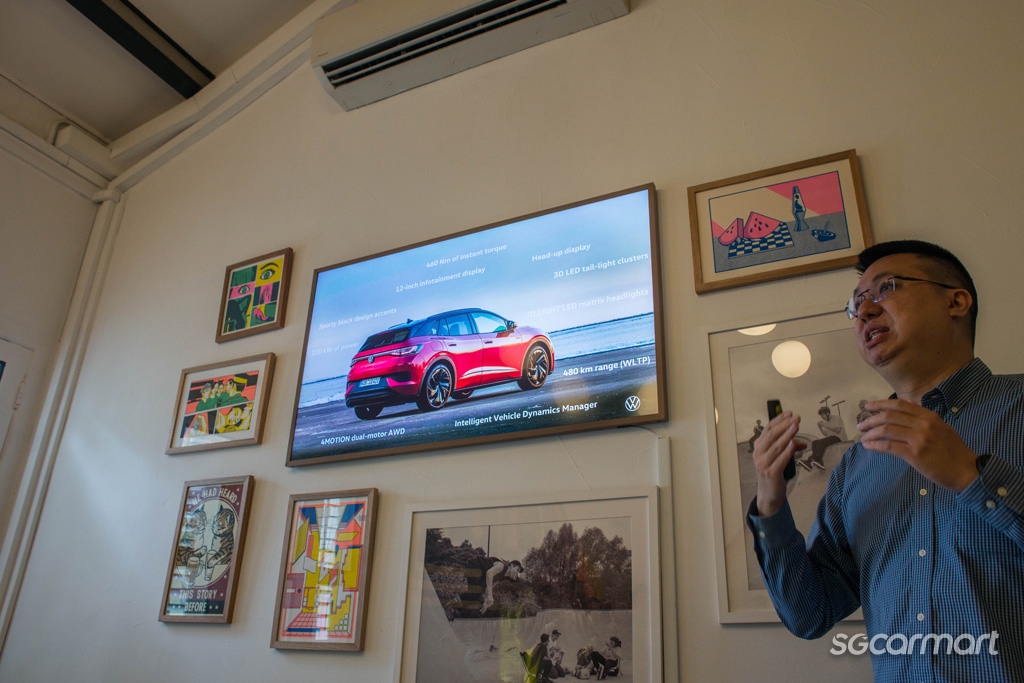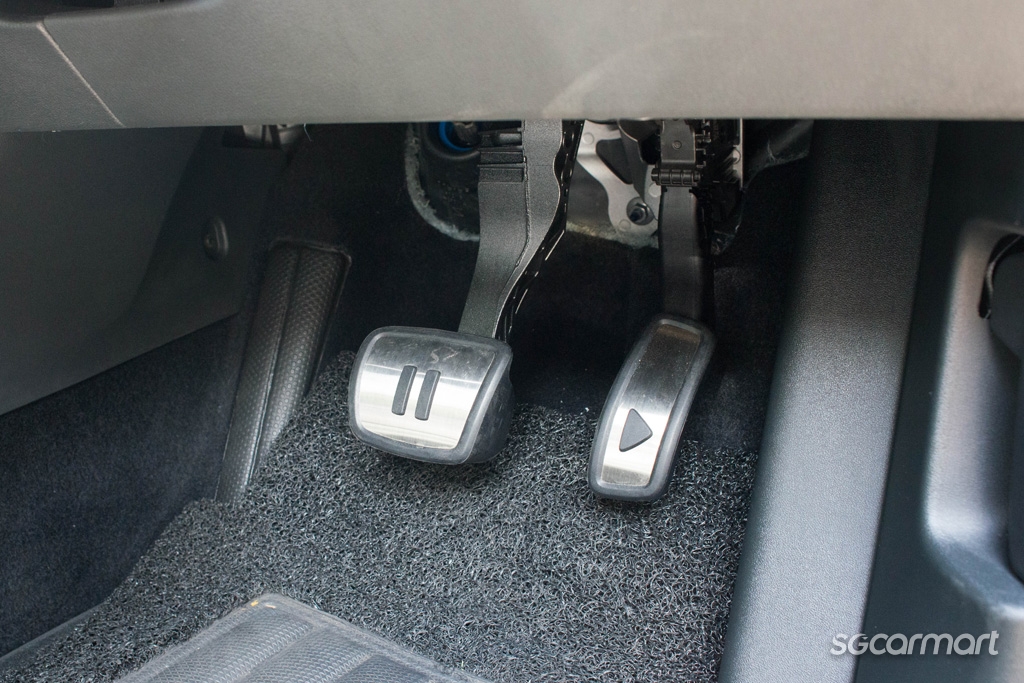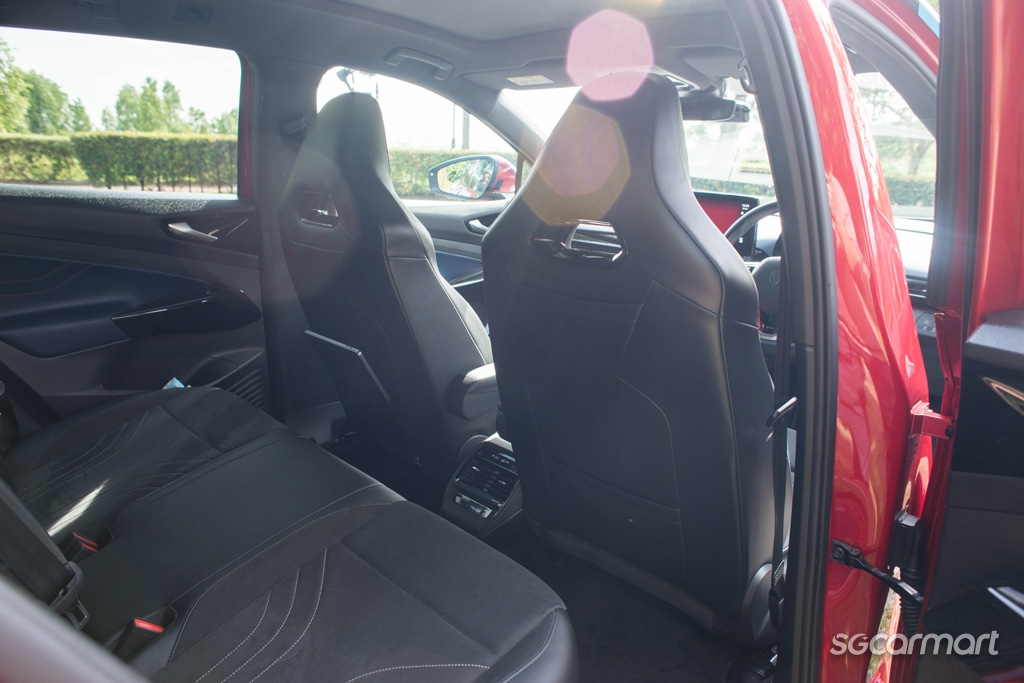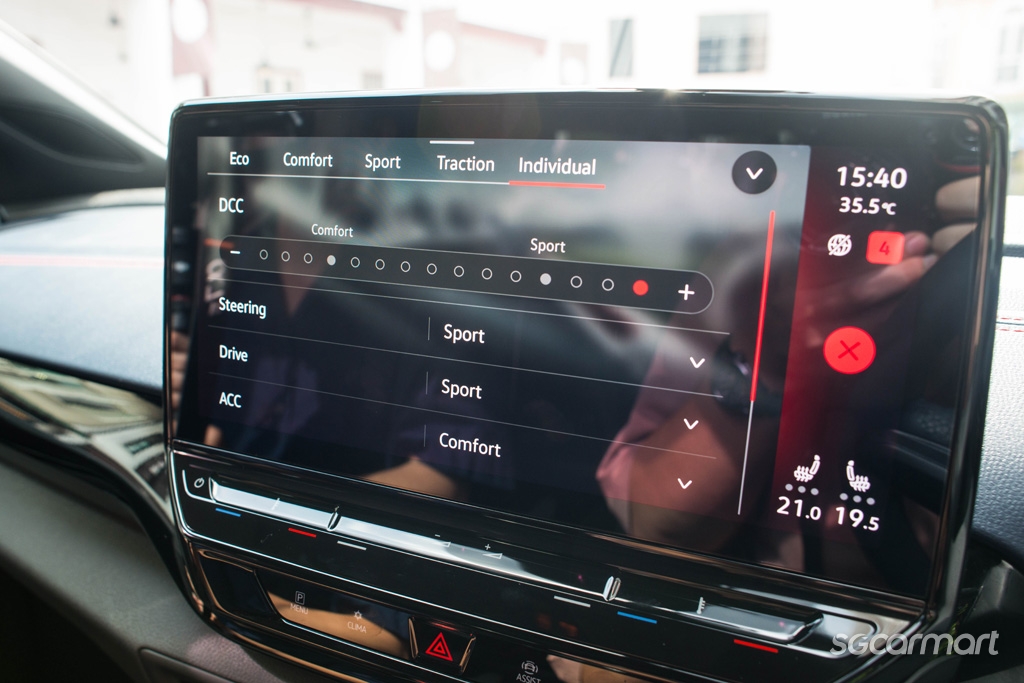Volkswagen ID.4 GTX First Drive Review
29 Jun 2023|4,114 views
What We Like
Smooth power delivery that is easy to get used to
Unique, pleasant design
Easy to drive
A very useable range, especially for Singapore's city-dwellers
What We Dislike
Steering feedback is rather vague
Brake pedal feel - there's a significant amount of dead-zone and braking feels weak initially
All cars of the Volkswagen I.D. family are built upon the new full-electric Modular Electric Drive Matrix (MEB), and to give the media a taste of these futuristic electric vehicles, we were invited by Volkswagen and Skoda Singapore to enjoy a day of sustainability.
Like the sumptuous spread of vegan dishes that we had for lunch, the cars that we got to drive were all about sustainability. With the Volkswagen ID.4, ID.4 GTX and the Skoda Enyaq to experience, I decided to hone in on the ID.4 GTX - it was the most powerful car in the lineup on the day!
I didn't eat one too many tasty plant-based meat substitute, fall into a food coma and mistype. If you are wondering, the GTX comes from a familiar nomenclature. Like how the GTI is the name for the sporty petrol-powered Volkswagens that we know and love, and how the GTD is the one for the diesel versions, the GTX depicts a sporty electric Volkswagen - why 'X' though, you'll have to check with Volkswagen.
And with it being a sporty electric machine, I'll just dive right into the exciting figures. Unlike its rear-motor peers, the ID.4 GTX gets an additional motor up front, powering the front wheels to offer an improvement in power output - power is bumped up to 295bhp (the regular ID.4 only has 201bhp), while torque is bumped up by 150Nm to a respectable 460Nm.
Furthermore, with its 77kWh net battery capacity, the ID.4 GTX has a range of 480km (WLTP) - likely sufficient for a week of usage.
The ID.4 GTX sure is a brisk drive, though it does seem that Volkswagen is truly serious about the proposition of the I.D. cars as the people's electric cars - despite the ability to put out neck-snapping torque (as observed from other EVs), the ID.4 GTX's power output can be described as smooth and reserved. I would expect first-time EV drivers to be able to step right in and drive off without getting the shock of their lives when they try pushing down hard on the skinny pedal.
It's clear the I.D. range of cars are meant to be as easy to drive as possible. To start driving, you simply hop into the driver seat, with the key fob, and the car will be started - just put it in 'D' and off you go. All controls are light and easy to operate as well, so you don't need to have big muscles to operate these modern EVs.
That said, despite being a performance variant, the GTX still doesn't evoke the same dynamism that we've all come to expect from cars such as the Golf GTI. The steering on the ID.4 GTX is lightweight, quick and precise, but I found it to be less than communicative when driven hard. Likewise, the brake pedal feel of the ID.4 GTX takes some getting used to.
Likely due to the programming of the regenerative braking system, the brake pedal seems to have a substantial amount of dead-zone before the brakes really clamp on - for first timers, it feel as though the brakes aren't strong enough to slow the car down.
However, these are all quirks that one would likely get used to over the duration of a couple of short drives around town. Nothing too major, considering how different these cars are from their conventional internal combustion engine counterparts.
Fun, futuristic design with a clear emphasis on sustainability
Like its peers in the I.D. family, the ID.4 GTX looks rather different the old Volkswagens that we are used to. All these I.D models have a smooth, flowy exterior, and it isn't just for the sake of being different - the ID.4 GTX has a low drag coefficient of 0.28, allowing energy to be saved while the car is travelling at speed.
Inside, the ID.4 GTX once again adopts a sustainable vision, with the use of vegan ArtVelours seat covers. The rest of the interior is chic and modern, with a floating digital cluster and gear selector that are located to the right of it. At the rear, the air-condition vents are positioned low to the floor, presumably to create an airy feel within the cabin. And indeed, the cabin of the ID.4 GTX feels spacious and comfortable to be in.
As expected of a forward-thinking offering, the ID.4 GTX comes with a slew of features and driver assists, such as adaptive cruise control, Dynamic Chassis Control (DCC) and several others to create a conducive environment for a pleasant journey.
At this moment, there is no word on the expected pricing of the ID.4 GTX. In fact, even the specifications aren't set in stone at the moment. However, interested parties can expect to be able to indicate their interest in this car towards the end of this year. The ID.4 GTX is expected to reach our shores early next year, so if you are a fan of sustainable and funky EVs, you'd better keep your eyes peeled!
Are Electric Vehicles your kind of thing? Here are some other interesting ones to read about:
Hyundai Ioniq 5 Prestige 58kWh Review
What We Like
Smooth power delivery that is easy to get used to
Unique, pleasant design
Easy to drive
A very useable range, especially for Singapore's city-dwellers
What We Dislike
Steering feedback is rather vague
Brake pedal feel - there's a significant amount of dead-zone and braking feels weak initially
All cars of the Volkswagen I.D. family are built upon the new full-electric Modular Electric Drive Matrix (MEB), and to give the media a taste of these futuristic electric vehicles, we were invited by Volkswagen and Skoda Singapore to enjoy a day of sustainability.
Like the sumptuous spread of vegan dishes that we had for lunch, the cars that we got to drive were all about sustainability. With the Volkswagen ID.4, ID.4 GTX and the Skoda Enyaq to experience, I decided to hone in on the ID.4 GTX - it was the most powerful car in the lineup on the day!
I didn't eat one too many tasty plant-based meat substitute, fall into a food coma and mistype. If you are wondering, the GTX comes from a familiar nomenclature. Like how the GTI is the name for the sporty petrol-powered Volkswagens that we know and love, and how the GTD is the one for the diesel versions, the GTX depicts a sporty electric Volkswagen - why 'X' though, you'll have to check with Volkswagen.
And with it being a sporty electric machine, I'll just dive right into the exciting figures. Unlike its rear-motor peers, the ID.4 GTX gets an additional motor up front, powering the front wheels to offer an improvement in power output - power is bumped up to 295bhp (the regular ID.4 only has 201bhp), while torque is bumped up by 150Nm to a respectable 460Nm.
Furthermore, with its 77kWh net battery capacity, the ID.4 GTX has a range of 480km (WLTP) - likely sufficient for a week of usage.
The ID.4 GTX sure is a brisk drive, though it does seem that Volkswagen is truly serious about the proposition of the I.D. cars as the people's electric cars - despite the ability to put out neck-snapping torque (as observed from other EVs), the ID.4 GTX's power output can be described as smooth and reserved. I would expect first-time EV drivers to be able to step right in and drive off without getting the shock of their lives when they try pushing down hard on the skinny pedal.
It's clear the I.D. range of cars are meant to be as easy to drive as possible. To start driving, you simply hop into the driver seat, with the key fob, and the car will be started - just put it in 'D' and off you go. All controls are light and easy to operate as well, so you don't need to have big muscles to operate these modern EVs.
That said, despite being a performance variant, the GTX still doesn't evoke the same dynamism that we've all come to expect from cars such as the Golf GTI. The steering on the ID.4 GTX is lightweight, quick and precise, but I found it to be less than communicative when driven hard. Likewise, the brake pedal feel of the ID.4 GTX takes some getting used to.
Likely due to the programming of the regenerative braking system, the brake pedal seems to have a substantial amount of dead-zone before the brakes really clamp on - for first timers, it feel as though the brakes aren't strong enough to slow the car down.
However, these are all quirks that one would likely get used to over the duration of a couple of short drives around town. Nothing too major, considering how different these cars are from their conventional internal combustion engine counterparts.
Fun, futuristic design with a clear emphasis on sustainability
Like its peers in the I.D. family, the ID.4 GTX looks rather different the old Volkswagens that we are used to. All these I.D models have a smooth, flowy exterior, and it isn't just for the sake of being different - the ID.4 GTX has a low drag coefficient of 0.28, allowing energy to be saved while the car is travelling at speed.
Inside, the ID.4 GTX once again adopts a sustainable vision, with the use of vegan ArtVelours seat covers. The rest of the interior is chic and modern, with a floating digital cluster and gear selector that are located to the right of it. At the rear, the air-condition vents are positioned low to the floor, presumably to create an airy feel within the cabin. And indeed, the cabin of the ID.4 GTX feels spacious and comfortable to be in.
As expected of a forward-thinking offering, the ID.4 GTX comes with a slew of features and driver assists, such as adaptive cruise control, Dynamic Chassis Control (DCC) and several others to create a conducive environment for a pleasant journey.
At this moment, there is no word on the expected pricing of the ID.4 GTX. In fact, even the specifications aren't set in stone at the moment. However, interested parties can expect to be able to indicate their interest in this car towards the end of this year. The ID.4 GTX is expected to reach our shores early next year, so if you are a fan of sustainable and funky EVs, you'd better keep your eyes peeled!
Are Electric Vehicles your kind of thing? Here are some other interesting ones to read about:
Hyundai Ioniq 5 Prestige 58kWh Review
Thank You For Your Subscription.
- Performance
- Drive
- Conclusion





















